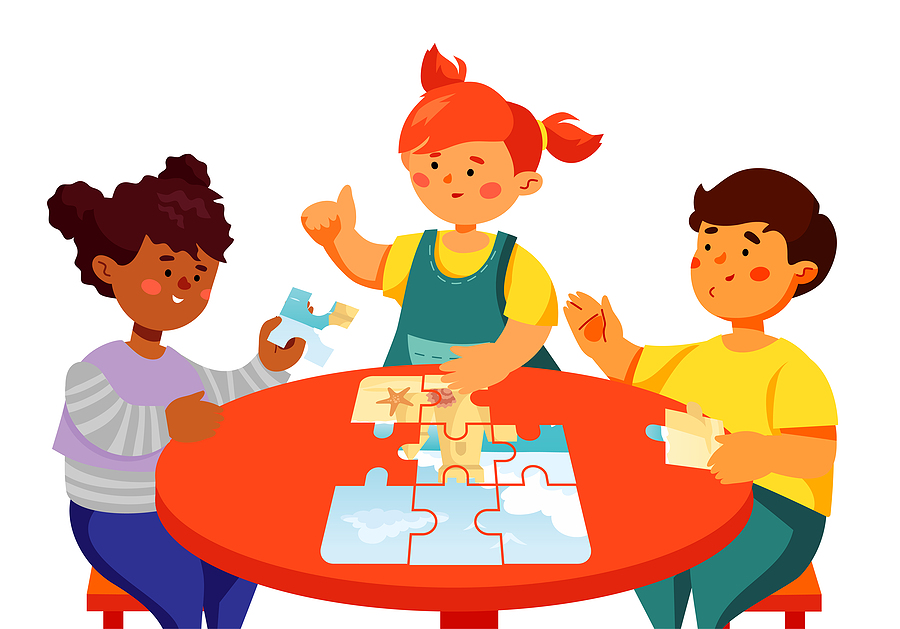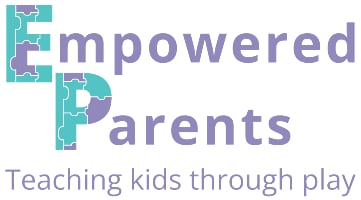Jigsaw puzzles are one of my favourite resources for young children. They come in all shapes and sizes, and vary in difficulty, making them appropriate for a wide variety of ages, even into adulthood.
Puzzles are important for toddlers’ development and they are crucial during the preschool and kindergarten years.
Puzzles develop many skills, making them the perfect educational play activity during the early years.
Here are a few of the benefits of doing jigsaw puzzles in early childhood.
1. Fine Motor Skills
Puzzles are an excellent tool for developing fine motor skills.
As children handle the small pieces, they strengthen their finger muscles. They have to pick them up, turn them and hold them carefully to join them together, which requires good control.
As with other fine motor activities, make sure the size of the pieces is appropriate for a child’s age and development. Younger children need to practise with larger puzzle pieces before they can learn to handle small ones.
2. Gross Motor Skills
Certain puzzles, like large floor puzzles, can also develop gross motor skills.
As children need to move their bodies around while building them, they strengthen the larger muscles.
The motion of stretching across the body to pick up a piece to the left or right of a child, or placing it in position by leaning across the centre of the body, is great for learning to cross the midline.
3. Visual Perception
When children build puzzles, their eyes are seeing the shapes, images and forms on the pieces and this information gets sent to the brain, to interpret it. This is called visual perception.
Without this skill, you would not know or understand why two pieces should connect together, or how they form a part of the bigger picture.

Visual perception is important for learning to read and write, which makes building puzzles a great early literacy and pre-writing activity.
Puzzles build several aspects of visual perception such as:
- Visual memory – The ability to remember what is seen.
- Visual discrimination – Seeing similarities and differences in things.
- Visual comprehension – Making sense of what you see.
- Perception of shapes – Recognizing common shapes.
- Visual analysis and synthesis – Seeing patterns and putting them together.
- Visual closure – The ability to identify what an object is by seeing part of it (e.g. a piece of an eye on a puzzle piece).
4. Eye-Hand Coordination
Also part of developing visual skills, eye-hand coordination is the ability of the hands and the eyes to work together to function and perform tasks, such as catching a ball or tying a shoelace.
Building puzzles from an early age is a simple way to build eye-hand coordination and develop a child’s visual-motor integration, also an important skill for learning to write.
5. Early Maths
During puzzle play, children learn to see patterns and shapes, in the pieces as well as in the complete picture.
Shape recognition is an important aspect of geometry, and patterns can be found in almost all mathematical concepts.
6. Attention Span
Have you ever noticed that when a child puts a jigsaw puzzle together they are sitting still for a few minutes longer than usual and they appear to be lost in what they are doing?
This activity is an excellent one for getting a child to focus all their attention, without getting distracted, and it’s one that can slowly train a child to concentrate for longer and longer periods.

With many other activities, a child can begin and stop as soon as the mood strikes. A puzzle, however, is not complete until every piece has been built.
This creates motivation for a child to keep going until it is complete, along with a sense of achievement.
7. Problem-Solving
Take a closer look at children building puzzles and you will see the smoke coming out of their ears. Puzzles make them think hard.
A puzzle is just that – a puzzle. It needs to be figured out – in a logical way, through trial and error, or by matching colour, shape, pattern, etc.
Teaching children about problem solving should happen during play, by giving them ample opportunities to practise this skill.
8. Independent Play
Playing with puzzles is a great way to encourage independent play. It’s an activity that doesn’t need adult intervention, and it can be happily done without peers.
This can help children learn to entertain themselves, especially when they are young and constantly seeking adult attention.
By playing for pockets of time on their own, they learn to find ways to play and stimulate themselves, and also learn the joy of some private, quiet time.
9. Spatial Relations
Developing spatial relations is about learning how objects are positioned in space, relative to each other.
This is important for reading and writing and understanding how numbers and letters are positioned, as well as their orientation (e.g. differentiating between letters b and d).
10. Cognitive Development
Building jigsaw puzzles in early childhood has all-around cognitive benefits.
According to sciencedaily.com, research also shows that the types of puzzles a child can do actually shows their level of cognitive development. While a three-year-old mainly builds a puzzle using trial and error, a four-year-olds matches the pieces based on information in the picture.
Children need to have reached a certain level of development in order to successfully build puzzles.
You can see the progress in your own children as they begin to understand how the pieces fit together, and that they are not random.
They may also start to follow their own process – such as building the border first or starting with pieces that look similar.

11. Confidence
Being able to complete a puzzle is a huge confidence booster for a child, especially since they did it all on their own.
It gives a child a sense of competence and achievement.
For this very reason, it is important to offer children age-appropriate puzzles. The puzzle should be a challenge, but possible to complete independently.
A child who is battling and struggling through a puzzle will get frustrated and eventually give up. They will also be less likely to reach for a puzzle next time.
12. Perseverance
A child who is dedicated to completing their puzzle and goes on to finish it, even though it requires concentrating for longer than they usually can, is a child who is developing perseverance.
This is a skill that is useful in every aspect of school and life after school.
Kids also need to get past the frustration of not matching the correct pieces and making several mistakes, in order to build a bit of grit and determination.
13. Relaxation
Last but certainly not least, building puzzles is such an enjoyable and calming activity, that even many adults enjoy doing them.
It releases stress, encourages mindfulness and is a good way to calm an anxious child. It is also a great activity to do when you want to wind down from an active play session.
These are just some of the many benefits of puzzles for toddlers and kids in preschool/kindergarten.
Get your own set of printable puzzles here! These are fun to add to your collection but shouldn’t replace real puzzles, as kids need to master how to join physical pieces:

Here is a list of the best puzzles for toddlers and puzzles for preschoolers.

